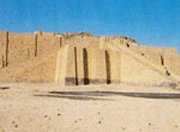The stone city was a repeatedly failed experiment for 5000 years. In Turkey Gobekli Tepe became one of the earliest examples of organised society, but was unable to maintain itself; in Palestine ancient Jericho came and fell; and again in Turkey another attempt with limited success, under the name of Catal Huyuk.
Then, around 4000 BC, the concept finally took root in Mesopotamia. The lands that accompanied the Tigris and Euphrates became populated within a string of fortified ziggurats, founded by a people known to us as the Sumerians.
The city didn’t simply change the geographical landscape, but also the human landscape and our development towards civilisation. A city needs organised agricultural, transport systems, and a centralised body for controlling them. Writing is required to deal with the logistical challenge. And with the sense of city was born the first real sense of nationhood, then would only find expression in the empires that followed. No longer would people be identified in terms of nomadic tribes, but in terms of a fixed geo-political community.
The Sumerians were conquered by the Akkadians, then later, the Babylonians. Cities were destroyed by another, but then rebuilt. Each civilisation was a flourish that sought to build on the achievements on the former.
Soon enough the famous empire of Persia would rise from Assyrian ashes, only to be conquered by the Macedonian known to history as Alexander the Great, spreading European thought across Asia in the form of Hellenistic culture. But the lifestyle of Asia conquered Alexander, and soon it became the dominion of the Seleucids.
By the time the Roman Empire faced East it was the Parthians who ruled from the seat of civilisation, before a brief re-emergence of the name of Persia under the Sassanid Kings was thrashed down by the sudden might of Islam.
This section records the literature of that ancient time, collecting together key translated texts and works of commentaries, that seek to bring together the world of Ancient Mesopotamia.

